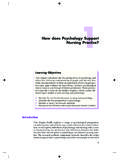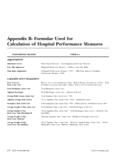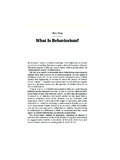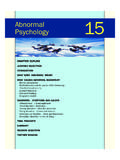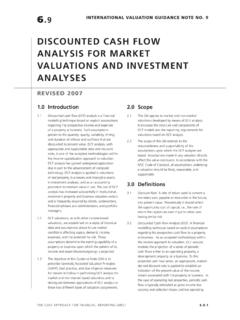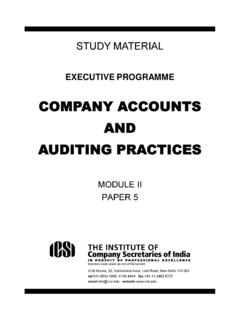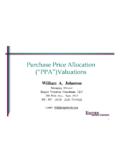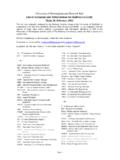Transcription of Chapter 5 Property Investment Valuation - Wiley …
1 IntroductionAround half of all commercial and industrial properties in the UK are held as investments, where the ownership interest is separate from the occupation interest. The landlord leases the Property to an occupying tenant or ten-ants. Investors in UK commercial Property include large financial institutions such as pension funds and insurance companies (28%), overseas investors (15%), UK listed Property companies (14%), UK private Property compa-nies (15%), limited partnerships, landed estates, charities, trusts, unitised and pooled funds and private investors (23%) (IPF, 2005). The majority of commercial Property investments can be placed in one of three principal sec-tors: retail (shopping centres, retail warehouses, standard shops, supermar-kets and department stores), offices (standard offices and business parks); and industrial (standard industrial estates and distribution warehousing).
2 Investment market sub-sectors are often defined using a combination of this sector classification and their location, City of London offices or south west high street retail , for example. There are also several smaller sectors of the Property market that attract Investment interest such as leisure parks, restaurants, pubs and that is typically held as an Investment is valued with this purpose in mind; the valuer will capitalise the rental income produced by the Property at an appropriate Investment yield using the Investment method of Valuation , as we saw in Chapter 3. The underlying principle is to discount net economic benefits from an Investment over its predicted life at a specified rate of return or discount rate. Chapter 2 described discounting as the process of finding the present value (PV) of expected net benefits that may be in the form of a regu-lar income, a future capital reversion or a combination of the two (Havard, 2000).
3 The all-risks yield (ARY) technique described in Chapter 3 is based on the assumption that there is a relationship between the price paid (capi-tal value) and the annual return (net rental income). This Chapter develops this notion more explicitly and describes a technique for valuing a Property Chapter 5 Property Investment 2488/18/2007 12:10:21 PM8/18/2007 12:10:21 PMProperty Investment Valuation 249 Chapter 5investment that involves more direct recourse to the underlying cash-flow characteristics of the Investment . Before that, though, a history until the 1960s landlords who wished to lease commercial properties typically did so using long leases with no rent reviews. Investment in these commercial premises was regarded as low risk. Consequently the required (or target) rate of return was closely linked to similar low-risk investments such as gilts. Conventionally a premium of around 1 2% was added to the redemption yield on long-dated gilts to account for Property market risk.
4 Long-dated gilts were used as a benchmark because Property was regarded as a long-term Investment . Valuation of Property investments involved ana-lysing comparable evidence to determine the appropriate yield which was, in fact, mathematically and logically equivalent to the target rate of return (TRR) (Baum and Crosby, 1995). No adjustment was made to either the yield or the rent to reflect income or capital growth because there was none. A typical Investment Valuation prior to the 1960s is shown below. Market rent (MR)( )10 000 Years purchase (YP) perpetuity @ 10%a10 Valuation ( ) 100 000aInvestor s target return and therefore comparable with other the 1960s, and a period of limited supply of new commercial and indus-trial Property and restrictive macroeconomic policy, commercial Property rents increased significantly and landlords introduced rent reviews into shortening leases so that they did not miss out on rising rents.
5 Property became a growth Investment , more like equities than fixed interest bond investments, albeit with a peculiar income pattern that goes up (usually) every 5 years (Havard, 2000). Investors were prepared to accept a lower return at the start of the Investment term in expectation of higher returns later on. Property Investment Valuation techniques handled this change not by explicitly forecasting rental growth but by capitalising the current rent at an ARY (derived from comparable evidence) that is lower than the TRR because it implies future rental income and capital growth expectations. The gap between the two represented the expected or implied rental growth hidden in the Valuation directly analogous to the concept of a reverse yield gap between equities and bonds (Baum and Crosby, 1995). Consequently, the assumed static cash-flow is not the expected cash-flow, the yield is not the target rate and is not comparable to target or discount rates used to capitalise or value income from other investments.
6 A typical Investment Valuation after the 1960s is shown ( )10 000YP perpetuity @ 8% ( ) 125 000aGrowth implicit ARY, not the target rate and therefore not comparable with other Chapter 3 we know that the ARY Investment Valuation technique relies on comparison to justify adjustments to initial yields obtained from 2498/18/2007 12:10:21 PM8/18/2007 12:10:21 PM250 Property ValuationChapter 5comparable Investment transactions. These adjustments account for all factors that influence Investment value except those that can be handled by altering the rent such as regular/annual management and maintenance expenditure. The most important Investment characteristics that need to be reflected in the ARY are income and capital risk and growth potential, but influencing these characteristics are a multitude of economic and Property -specific factors including macroeconomic conditions, Property market and subsector activity, the financial standing of individual tenants, Property depre-ciation and changes in planning, taxation, landlord and tenant legislation.
7 The ARY has to implicitly quantify these factors and the all-encompassing nature of the ARY means that capital value is very sensitive to small adjust-ments. In essence, a single divisor (ARY) or multiplier (YP) conceals many of the assumptions regarding choice of TRR (which includes risk) and income and capital growth , the ARY approach is practical and appropriate where there is a plentiful supply of comparable market transactions providing evidence of yields, rents and capital values. But there are circumstances when it is par-ticularly difficult to use the ARY technique to value a Property Investment . Problems arise when, first, comparable evidence is scarce, either because market activity is slow or the Property is infrequently traded, and second, where there is greater variability in investments, meaning more variables must be accounted for in the ARY. Regarding this latter point, we saw in Chapter 4 how flexi-lease terms are creating greater diversity in Property Investment cash- flows , often with gaps in rental income.
8 But, in addition to that, non-prime properties are generally more variable in terms of location, physical quality, condition or covenant and are therefore more risky. And problems arise where the Property is more complicated than a simple rack-rented Investment : the ARY technique is inappropriate for valuing Property that is over-rented, let on short leases or produces varying rental income streams from multiple tenants. It can be especially difficult to quantify all of these factors in an ARY when comparable evidence is (2000) notes that increasing diversity in the Property Investment market has undermined the ARY Valuation technique because it relies heav-ily on comparison between relatively homogeneous Investment assets and simple adjustments to comparable evidence. As a result, Property Investment Valuation techniques have emerged that focus more explicitly on the TRR that an investor requires, the expected flow of income, expenditure and capital growth that might be expected from an Investment .
9 The discounted cash-flow (DCF) technique uses an established financial modelling technique that allows comparison between Property and other forms of Investment . Where information is scarce, or when an unusual Property is being val-ued, the DCF technique assists in the consideration of income and capital growth, depreciation, timing of income receipts and expenditure payments and the TRR. Indeed, International Valuation Standards now include guid-ance on the use of DCF analysis for Valuation in GN9 discounted Cash Flow Analysis for Market and Non-market Based Valuations (IVSC, 2005). The guidance describes how DCF analysis involves the projection of a 2508/18/2007 12:10:21 PM8/18/2007 12:10:21 PMProperty Investment Valuation 251 Chapter 5flow for an operational or development Property . This projected cash-flow is discounted at an appropriate market-derived discount rate to establish PV.
10 In the case of standing Investment properties, the cash-flow is typically a series of periodic net rental incomes (gross income less expenditure) along with an estimate of reversion value anticipated at end of the projection period. In the case of development properties estimates of capital outlay, development costs and anticipated sales income produce a net cash-flow that is discounted over the projected development and marketing periods (cash- flows from Property development will be covered in the Chapter 6). The guidance note discusses the structure and components of DCF models and the reporting requirements for valuations based on DCF A DCF Valuation modelThe academic case for valuing Property investments by capitalising a DCF at a TRR rather than capitalising an initial income estimate at an ARY derived from comparable evidence began in the late 1960s and continues to this day.





